Bookshelf is a monthly column examining printed matter relating to television. While I love watching TV, I also love reading about it, from tie-in novels to TV Guides, from vintage television magazines to old newspaper articles.
The Wonderful World of TV Soap Operas
By Robert LaGuardia
First Published September 1974
First Special Printing February 1976
Published by Ballantine Books
342 Pages
I have seen exactly one episode of one soap opera in my life. It was an episode of General Hospital that I watched when I was home sick from school back in the late 1990s or early 2000s ( I can’t remember exactly when). Understandably, I was completely lost but I seem to recall enjoying it. Other than that, I am not really a soap opera person.
Television Obscurities, with few exceptions, focuses on prime time programming, so you won’t find a lot of information about soap operas here. One such exception is my article on short-lived NBC soap opera Miss Susan starring Susan Peters, which ran from March to December 1951.
I purchased a lot of 50+ TV tie-ins on Ebay a number of years ago and included was a copy of Robert LaGuardia’s The Wonderful World of TV Soap Operas. Originally published in September 1974, it offers a history and examination of soap operas on television as well as in-depth plot histories for 15 individual soap operas, current as of July 1974.
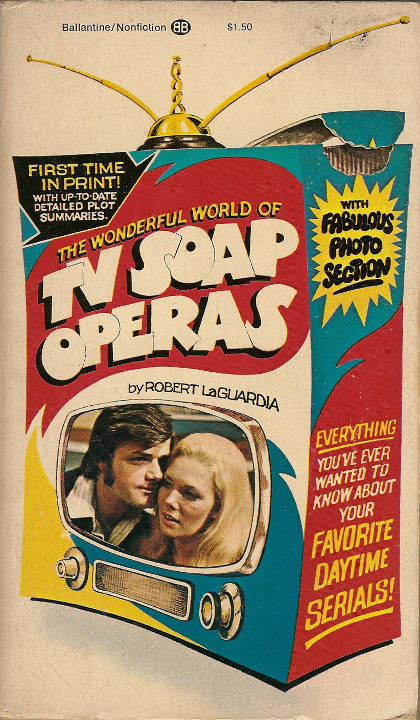
Front cover to The Wonderful World of TV Soap Operas – Copyright 1974 Ballantine Books
I only read select chapters from the book and not the entire thing. In the first chapter (titled “The Daytime Dramas of Yesterday and Today”) LaGuardia makes very clear his distaste for prime time programming — “ugly, crime-centered shows, or unfunny-funny sitcoms about spiritedly women who are about as real as Alice in Wonderland” — that he calls insipid and far less realistic than soap operas.
He also describes a shift in the critical and popular reaction to soap operas that occurred in 1968. Prior to that date, little regard was given to daytime serials. For some reason, however, in 1968 the tide changed and suddenly everyone was talking about soap operas in a positive light. Fan magazines launched. Budgets skyrocketed. Salaries soared. Actors and actresses were suddenly recognized wherever they went. No reason is given for why things changed in 1968.
The second chapter (“Live Tape!”) is a fascinating behind-the-scenes look at the production of a single episode of Another World. I skipped the third chapter, which discussed the long history of the Bauer family on The Guiding Light. The fourth chapter (“How Did the Serials Start?”) traces the history of soap operas on radio.
The fifth and sixth chapters were of the most interest to me.
In the fifth chapter (“Television Takes Over”), LaGuardia examines the early years of soap operas on television, which he states began with a one-off television version of the radio soap opera “Big Sister” in 1946, followed by a local Chicago soap opera called These Are Our Children, also in 1946, and a local New York City soap opera called A Woman to Remember in 1947. The first network soap opera, The First Hundred Years, debuted in 1950 on CBS and was followed in 1951 by two NBC soap operas: Miss Susan and Hawkins Falls.
(This history excludes DuMont’s Faraway Hill, often referred to as the first soap opera on television. It aired in prime time from October to December 1946).
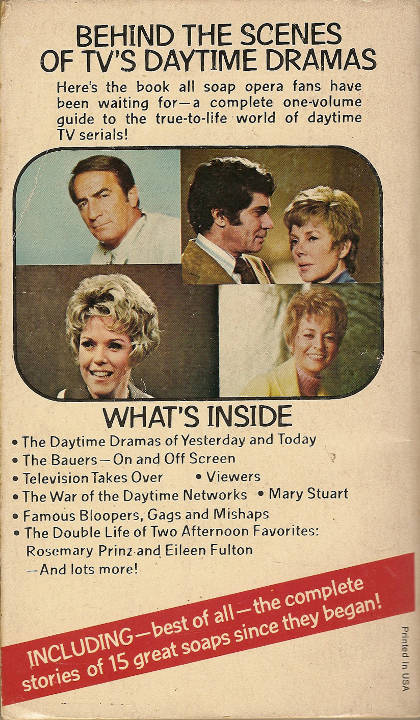
Back Cover to The Wonderful World of TV Soap Operas – Copyright 1974 Ballantine Books
The sixth chapter (“The War of the Daytime Networks”) covers the early 1960s when ABC and NBC attempted to topple CBS and its stable of popular soap operas. Introduced that year were General Hospital and The Doctors. Soon thereafter came Another World, Days of Our Lives and Dark Shadows.
Later chapters discuss reaction from viewers, famous mistakes made on soap operas, writing for soap operas and the future of soap operas. The last 130 pages are dedicated to plot summaries for soaps like All My Children, Another World, The Doctors, The Edge of the Night, How to Survive a Marriage and The Secret Storm.
As someone who doesn’t watch soap operas and doesn’t know all that much about them, I found the portions of The Wonderful World of TV Soap Operas that dealt with the history of the soap opera on television very interesting. I had no idea in 1960 CBS debuted a soap opera about astronauts called The Clear Horizon. I would love to know more about that show.

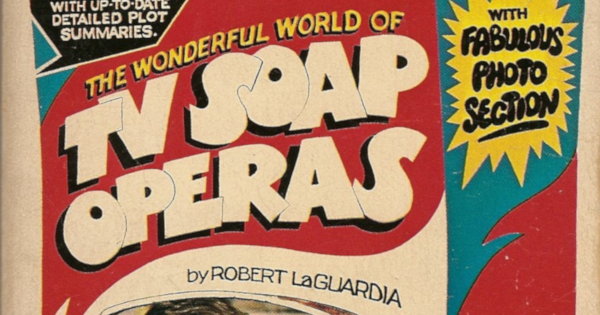
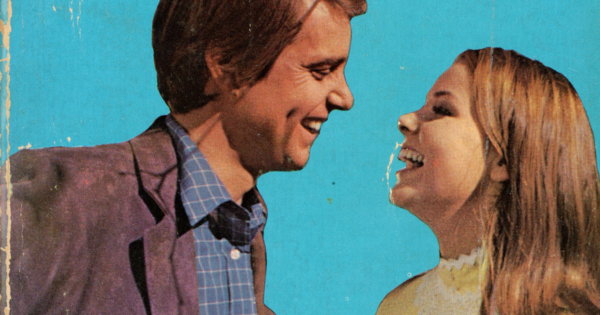
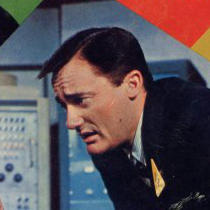
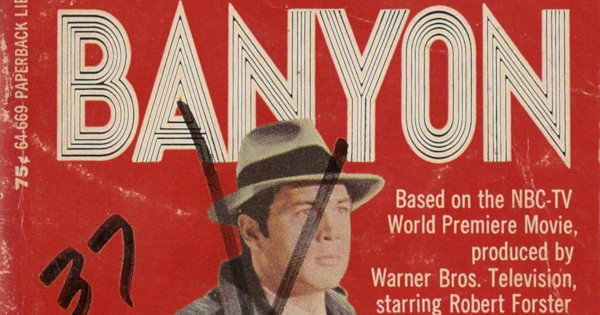



In 1975, the American soaps accounted for at least 20 percent of the ad revenue for each network. And even the lowest rated ones got at least six million viewers a day. As The World Turns was having viewership in about 12 million daily. At one time,daytime soaps had higher Nilelsen numbers that much of ABC’s prime time schedule.
THE CLEAR HORIZON’s opening and closing credits exist on YouTube. You’re correct in stating that it was about astronauts at a mythical Air Force base in Florida, but it’s much better known for its beautiful piano score.
CBS was known to trot out other soaps in the late ’50’s/early 60’s as almost extended pilots, to see what would fit with their juggernaut lineup. Another one of these would be FULL CIRCLE, starring a young Dyan Cannon. However, both of these soaps would be given their pink slips by early 1961
I should have followed some stuff up before posting originally. Only the closing credits to THE CLEAR HORIZON exist on YouTube, and the musical score was done by Kip Walton, who was later the composer of the original theme to GENERAL HOSPITAL
THE CLEAR HORIZON had 2 separate runs on CBS (due to the nature of daytime drama, I hesitate to call them seasons), the first being from July 11, 1960 until March 10, 1961; then from February 26-June 11, 1962-thus being one of the few daytime dramas to come back after an initial cancellation.
The premise was simple enough-the personal and professional lives of astronauts based at Cape Canaveral. In the first episode, Roy Selby (Ed Kemmer), and wife Anne (Phyllis Avery) received orders from The Pentagon to transfer to The Cape. Episodes in the first run dealt with the Selbys’ adjustment to Florida, as well as Anne’s growing attraction to another man; while episodes in the second run dealt with Anne adjusting to life alone while Roy was trapped behind enemy lines, In the final episode, the Selbys would be reunited.
Despite America’s growing fascinaton with all things space in the early 60’s, THE CLEAR HORIZON never really resonated with the public at large-its 3.5 rating for 61-62 ensured the final cancellation. Perhaps a move to another network would have produced better results.
Despite the lack of commercial success, THE CLEAR HORIZON was a trailblazer in the genre of daytime drama, being that it was the first to be shot in Southern California, as well as the first to use location shooting
Troy, do you know where I might be able to find a copy of Kip Walton’s original theme for General Hospital? Preferably full length and clean? TIA!
I love soaps been watching them for over 50 years days of our lives is the only one I watch now but I miss another world so much
We lost two greats in the world of soaps last week: Agnes Nixon, creator of “All My Children” and “One Life to Live”, and Larkin Malloy, who played Sky Whitney on “The Edge of Night” and Travis Montgomery on “AMC”‘ among others. May they both rest in peace.